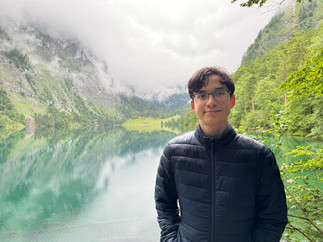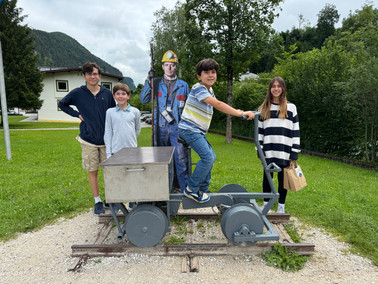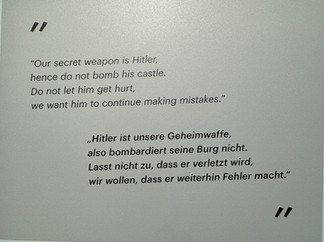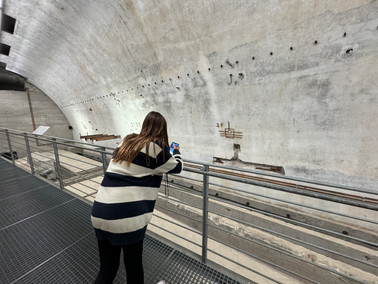Bucolic Berchtesgaden. A Regal Lake, a half Century old Salt Mine, and an Infamous Nest for the Nazis.
- Jana
- Aug 1, 2024
- 4 min read
Berchtesgaden is a true condradiction. On the one hand, it is a serene place with incredible natural beauty everywhere you look. On the other hand, it is and always will be inextricably tied to the Nazis. Here is how Wikipedia neatly sums up the area, "Berchtesgaden is a German town in the Bavarian Alps on the Austrian border. South of town, Hitler’s Eagle’s Nest retreat, the Kehlsteinhaus, has a restaurant with alpine views. The Dokumentation Obersalzberg museum chronicles the Nazi era. Salzbergwerk Berchtesgaden illuminates the salt mine’s 500-year history. Lifts lead to Obersalzberg and Rossfeld ski areas. To the south, trails cross Berchtesgaden National Park." I couldn't have summarized it better myself.
On our first full day in the area, we visited Lake Königssee (King's Lake), which lies just a few miles south of Berchtesgaden and is Germany's deepest and cleanest lake. This area has been used for outdoor recreation for centuries; Bavarian royalty and the local rulers of Berchtesgaden and Salzburg hunted here, Hitler went boating on the lake and Eva Braun liked to sunbathe on the shore. The day we visited wasn't ideal for sunbathing, but we enjoyed our scenic boat ride around the lake, a long hike, incredible views, and a glass of local buttermilk, just the same.
We loved our cozy hotel, just outside of Berchtesgaden and a literal stone's throw away from the Austrian border. We especially enjoyed their ample and delicious traditional German breakfast each morning.
On our second full day in Berchtesgaden, we visited the Salzbergwerk Berchtesgaden (salt mine). The mine is a significant historical site being the oldest active salt mine in Germany, at 500 years old. It is unique in its method of extraction, primarily using a wet process. The tour of the mine includes a train ride deep into the mountain, a steep slide that hurtles you a further 34 meters down into the Kaiser Franz Sink Work, a visit to the Magic Salt Room and Salt Cathedral, as well as a raft ride across the Mirror Lake, offering. a fascinating insight into the history and techniques of salt mining. You venture 650 meters deep into the earth, so this is not for those who suffer from claustrophobia, which I do, under certain circumstances. I made that realization a little late, as the train took off down the dark, cramped, and cold tunnel. I held on to Garin for dear life, who was sitting in front of me on the train. I simply tried to breathe and stay calm as poor Garin was trying to figure out why I was clinging onto him so tightly. I did a bit better once we got into the actual mine where there was more space, but my anxiety was constantly reignited every time our tour guide discussed potential mining accidents and eventual suffocation if things went wrong. Needless to say, I was happy to see the light of day as we exited the mine a few hours later. Note: No photos were allowed in the mine, so the only ones I have are ones I had to buy from them (convenient for the mine, of course). We especially enjoyed the gift shop and found some nice gifts to bring home. Who would guess that a salt mine would have such an enticing gift shop?
Our final stop of the day was at the Dokumentation Obersalzberg (Nazi Documentation Center) which is a museum, that provides information on the use of the mountainside retreat by Nazi leaders, especially Adolf Hitler, who regularly spent time in this area beginning in 1928. This was our second documentation center visit of the trip, but we found it equally fascinating and well-presented as the one in Nuremberg. Each center focuses on the Nazi activity specific to that area, so you learn and experience new things at each center.
They have preserved a portion of the intricate underground bunker system that was built at the time (by slave labor), which we were allowed to tour. When the Allied bombing campaign over the Third Reich became a reality in 1943, Reichsleiter Martin Bormann was forced to order the construction of a series of air raid shelters and command posts for the residents and military staff of the Obersalzberg. These tunnels are often called "bunkers" today, but they are not technically so, since they were not meant as defensive positions from which to fight (even though their entrances were protected by machine guns), but simply as shelters in case of air attacks. They were used successfully for this purpose during the Royal Air Force bombing attack on 25 April 1945. Elaborate shelter systems were built beneath the hill behind the Berghof, with tastefully furnished rooms for Hitler and his mistress Eva Braun.
The actual Eagle's Nest is a twenty-minute ride by bus (only) up into the mountains from the documentation center, but the main attraction these days is simply the view and since we had poor weather and visibility that day, we sadly made the decision to abort this part of our plan for the day.
In the afternoon, we got on the road for Austria, Salzburg to be specific, which was only a short 35 minutes away, to begin our next adventure.
Note: Graham has enjoyed learning German. He started by studying the terms in Rick Steves' book and after finishing those, took to perfecting his accent, which I must say sounds like a native. He has fun speaking the language and his new-found knowledge has proven to be most helpful as we travel around.

Remembering Fitzy...
This photo was taken on a bench in Central Park, New York. In May of 2010, Garin and I traveled to New York to visit friends and see the city. Fitzy joined us on the trip and was a big hit in the Big Apple!






























































































Comments